
foreword | Historical Narratives | Resources | Links | Contact
HMS ONTARIO
Black squalls swept across her deck and she was blasted down by the hammer of the lake.
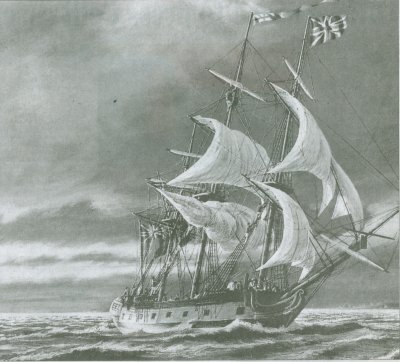 |
|
HMS Ontario driving downwind under full sail, [*]
|
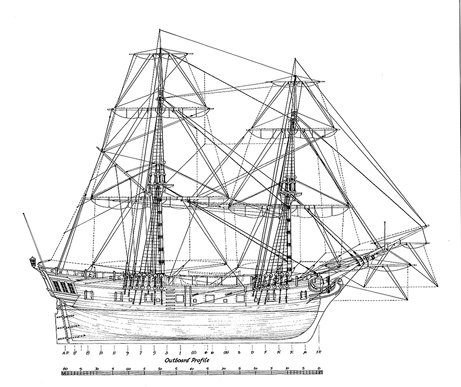 |
|
"A drawing of Ontario taken from a 1997 history of the Ontario. |
Both the British and the Americans recognized from the beginning of the American Revolution, that maritime might would be critical. Control of the waterways was vital since they were the best and often the only way of moving troops and supplies. George Washington declared, "Whatever efforts are made by armies, the navy must have the casting vote in the present contest." Washington knew whereof he spoke, for fortunately for the Americans, the French fleet arrived off the Chesapeake Capes and sealed the fate of the British army at Yorktown in 1781.
Thirteen years before in August 1758, Colonel John Bradstreet's artillery began a pounding barrage on Fort Frontenac's ageing 85-year stone walls against which "every shell did execution." The white fleur-de-lis quickly became the red flag of surrender. Bradstreet's successful assault on Fort Frontenac (Kingston, Ontario) severed the lifeline of the French Great Lakes' empire. The fort sat astride the main artery which sustained not only Fort Niagara and Fort Duquesne, but all of the upper Mississippi and Ohio valleys. Bradstreet's victory resulted in the destruction of the French naval flotilla that had given France control of Lake Ontario. Brigadier James Wolfe described Bradstreet's coup as "masterly."
In order to ensure it remained in British hands, Governor Haldimand needed ships to maintain the string of posts along the Great Lakes and to feed and provide for the other needs of the rapidly increasing number of Loyalists falling back to the rivers and lakes.
Early in the autumn of 1779 more than 5000 Indians flocked into the area around Fort Niagara, seeking help from Lieutenant-Colonel Masson Bolton's garrison. Bolton had to cope with this new situation which turned Niagara into a centre for food and shelter. The relay point was Carelton Island at the entrance of Lake Ontario from where consideration was being given to counter-attacks that would surprise the enemy. Haldimand worried about being able to supply these people over the winter
At Niagara several hundred of Butler's Rangers were established on either side of the river. Clad in uniform green jackets and buckskin breeches, furnished with weapons from the British army depot in Montreal and trained under Sir John Johnson, Major John Ross and Colonel John Butler, these resolute men carried war into the valleys of New York and Pennsylvania. Refugees from New York and Pennsylvania, many of them German or Huguenot in origin, formed the first permanent settlements since the arrival of the French Canadians at the opposite end of Lake Erie a generation earlier.
Haldimand ordered the construction of a fort on the Upper St. Lawrence on Buck Island. Located on the west promontory of the island at the east end of Lake Ontario, it was some 16 km from Kingston, The fort was intended as a military and commercial base of operations for British forces and their native allies. Named Fort Haldimand by its engineers, it was a substantial work with barracks, bastions and a blockhouse.
In 1779 Haldimand re-named the island Carleton Island in honour of his predecessor, Sir Guy Carleton. The island, which was a major British base during the American Revolutionary war, occupied a strategic site, commanding as it did entry from the river into Lake Ontario. It served throughout the American Revolution as an important ship-building centre and as a base from which destructive raids were carried out on the Mohawk Valley on crops, buildingss and cattle stored by the rebels.
Vessels on which Haldimand depended were constructed at the shipyards on Carleton Island.[***] Because they were built during wartime, each of them was wrapped in secrecy to prevent the revolutionaries knowing the extent of British naval strength. It was also important to deny Washington information regarding the weakness of Britain's western areas in the event a ship was lost.
Throughout the 18th and 19th centuries, ships and ship building were vital for transportation, trade and security. Regiments of British solders needed to be moved through the Lake Ontario region to meet the threat of Washington's armies. Loyalists were fleeing the revolutionary colonies and establishing new roots in the peninsula and farmers, merchants and fur traders needed to move their goods and products.
Laid down in October 1779, HMS Ontario, was launched on May 10, 1780. The brig-sloop was 25 metres (80 feet) long, had a 25-foot beam, a "burthen weight" (tonnage capacity) of over 226 tons and carried 22 cannons. This largest and most powerful vessel on the Great Lakes at the time, was used to secure Ontario from invasion through the Great Lakes and to deter an anticipated American attacks on Montreal via the Mohawk and St. Lawrence Rivers. It also supported Loyalist Ranger regiments' aggressive 'hit and run' raids along upper New York State.
British Admiralty ship plans of Ontario indicate just how complex it was to build a warship of 23 tons. The master shipwright's task was a daunting endeavour. The huge ships were actually very fragile and had a short lifetime in the harsh environment of the Great Lakes. To avoid tragedy and loss of life, Ontario's Captain, James Andrews, needed to be very familiar with the characteristics of his ship and knowledgeable about the rapidly changing nature of the lakes in which he sailed.
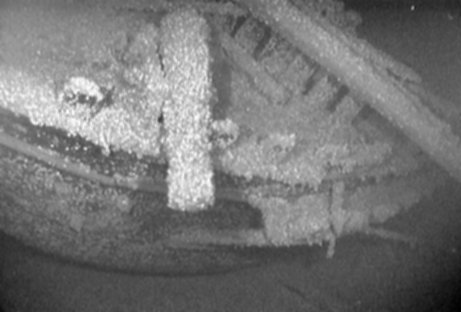 |
|
Ontario's Cannon |
Near the top of Ontario's two 25-metre masts, crow's nests served as a lookout stations and served during battles as a perch for musket-bearing snipers. During the summer of 1780, Ontario transported troops, stores and civilian goods around and across Lake Ontario, docking often at Niagara and Carleton Island.
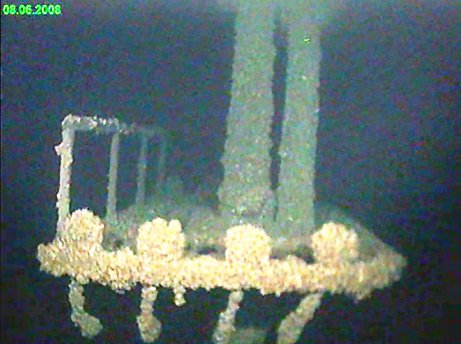 |
|
An Encrusted Crow's Nest |
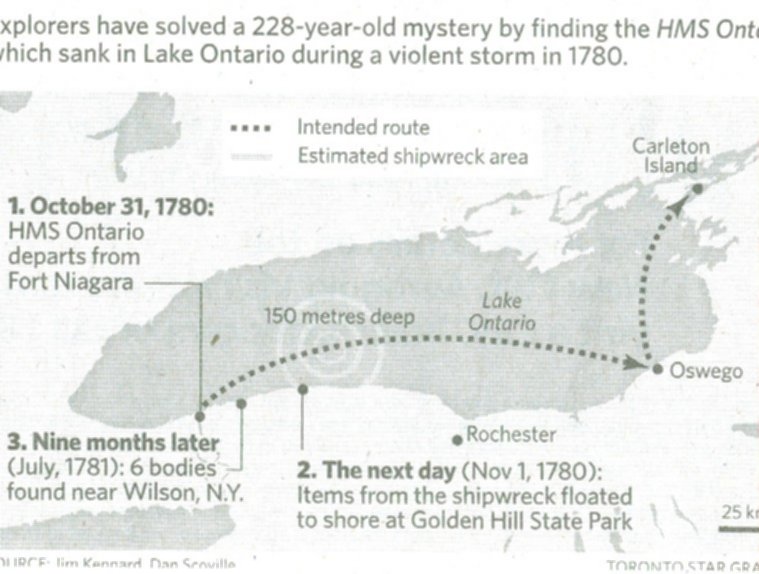 |
|
|
Six short months after His Majesty's 22-Gun Brig was christened Ontario, the valuable vessel, en route from Fort Niagara to Oswego and Fort Haldiand, was hit by a sudden onslaught of rain, wild winds and pounding waves that caused the ship to founder and find the deep on All Hollow's Eve, 1780. The cause of the catastrophe was an autumn nor'easter, spawned by the residue of a tornado that originated some 3000 miles away in the Caribbean Sea. According to one of the ship's finders, Jim Kennard, the winds that whipped the waves into a frenzy may have exceeded 97 kilometres (60 miles) an hour.
Admiralty records revealled that the ship's passenger list included: 75 crewmen, 60 British redcoats of the 34th (Cumberland) Regiment of Foot along with Lieutenant-Colonel Masson Bolton, Commander of Fort Niagara and his wife. Bolton was returning to England for the extraction of all his badly decayed teeth that were gradually poisoning his system. In addition to Captain James Andrews, who was also commodore of the lake squadron of ships, the those aboard included three other women, five children, four Indians and a merchant. Correspondence at the Fort indicated that there were also 30 American prisoners of war. All died in the disaster.
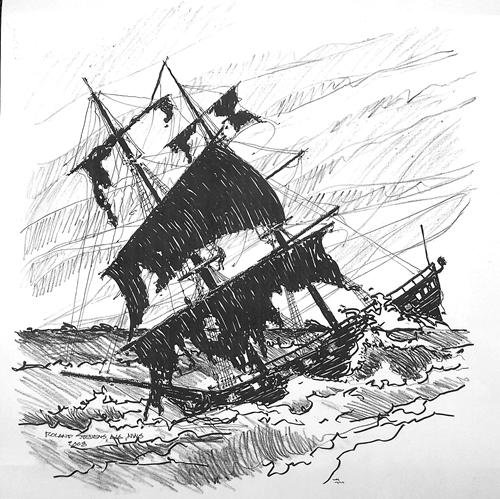 |
|
|
The following day, some of Ontario’s rowboats, its hatchway gratings, binnacle, compasses, hats and blankets drifted ashore in the area known today as Golden Hill State Park, located 30 miles east of Fort Niagara in New York State. An extensive search of land and water was carried out by the British a few days later, but the only things found adrift on the lake were the ship’s sails. In late July 1781, six bodies from the vesssel were recovered approximately 12 miles east of the Niagara River near Wilson, New York.
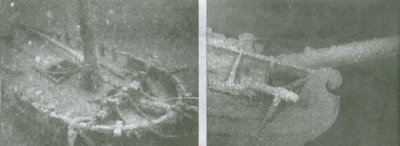 |
|
Ontario 228 years later |
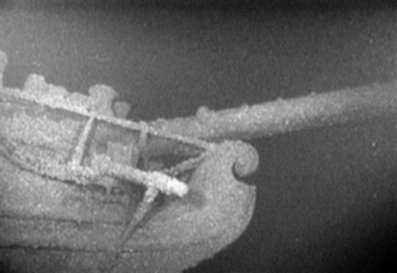 |
|
Ontario's Hand-carved Bow |
The ship's ornate, handcarved bow stem is a testament to the "personal pride" shipbuilders took in their vessels. The ship's sail would have been attached to the large forward pole or bowsprit at right.[From National Geographic News Dan Scoville & fellow shipwreck enthusiast Jim Kennard]
"No other items from the ship were discovered until HMS Ontario itself was spotted in deep water off the southern shore of Lake Ontario. Encrusted with quagga mussels, the vessel was found in June 2008 by ship-wreck enthusiasts Jim Kennard and Dan Scoville. The wreck is located between Niagara and Rochester, New York, in an area of Lake Ontario where the depth exceeds 150 metres (500 feet). Sonar imagery clearly revealed a large sailing ship resting upright at an angle, with two masts reaching up at least 70 feet (21 m) above the bottom of the lake. The high resolution images showed the remains of two crow's nests on each mast. This strongly suggested that the sunken vessel was the brig-sloop, Ontario. Because of the depth limitations for diving on this shipwreck, a remotely operated underwater vehicle was deployed and confirmed the identity of the ship." The vessel is the oldest wreck and the only intact British war ship found in Lake Ontario.
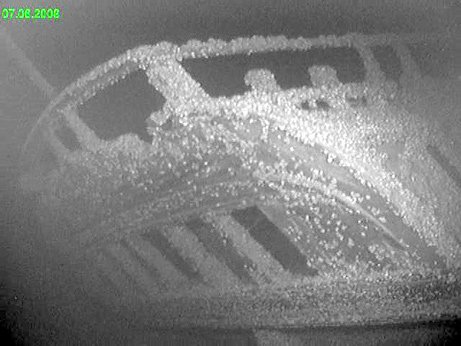 |
|
Ontario's Captain's Quarters |
The Union Jack would have flown from the flagpole (top left) at the stern of the warship. Some of the six windows of captain's quarters retained their panes according to the wreck's discoverers.
Shipwreck enthusiasts Jim Kennard and Dan Scoville used side-scanning sonar and an unmanned submersible to locate the HMS Ontario, which was lost with barely a trace during a gale in 1780. Designated a "holy grail" of Great Lakes wreck hunters, the prow of the 24-metre (80-foot) vessel is shown 150 metres (500 feet) below Lake Ontario near Rochester, New York. The 80-foot sloop of war is the oldest shipwreck and the only fully intact British warship ever found in the Great Lakes, Scoville and Kennard said. To this day, the exact location of the wreck remains a mystery. Many marine archeologists believe Ontario may remain in pristine condition in her deep, cold fresh water grave in the depths of Lake Ontario.
[*]Legend of the Lake: The 22-Gun Brig-Sloop Ontario, 1780 by Arthur Britton SmithShips Drawing: John W. McKay
Paintings: Peter Rindisbacher
Kingston, ON: Quarry Press, 1997 [**] The Americans also had a ship by the same name - Ontario. [***] Carleton Island was formally ceded to the United States in 1817. Ruins of the fort, that is privately owned, can still be seen at the southwest end of the island.
Copyright © 2013 Website Administrator